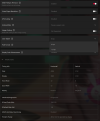Hey everyone,
I’ve been having an issue with my computer for a while now and I’ve narrowed it down to 2 causes, the primary cause being DSC. My current display just does not like DSC… like at all. So, I’m in a bit of a pickle because for some reason RDNA2 only supports FRL5. That means I’m limited to either 4K144 at 8-bit or 4K120 at 10.
I’m looking to swap out my graphics card now and sell off this 6800XT before it’s value completely tanks. I’m looking at the 7800XT due to pricing. I’ve found a few threads that show that the 7900XTX supports FRL6, but I don’t know if that applies to all RDNA3 cards. I don’t want to order 2 of them for my wife and I’s computer only to find out that it won’t actually fix the problem.
So yeah… Anyone know if the 7800XT supports FRL6 or not?
I’ve been having an issue with my computer for a while now and I’ve narrowed it down to 2 causes, the primary cause being DSC. My current display just does not like DSC… like at all. So, I’m in a bit of a pickle because for some reason RDNA2 only supports FRL5. That means I’m limited to either 4K144 at 8-bit or 4K120 at 10.
I’m looking to swap out my graphics card now and sell off this 6800XT before it’s value completely tanks. I’m looking at the 7800XT due to pricing. I’ve found a few threads that show that the 7900XTX supports FRL6, but I don’t know if that applies to all RDNA3 cards. I don’t want to order 2 of them for my wife and I’s computer only to find out that it won’t actually fix the problem.
So yeah… Anyone know if the 7800XT supports FRL6 or not?

